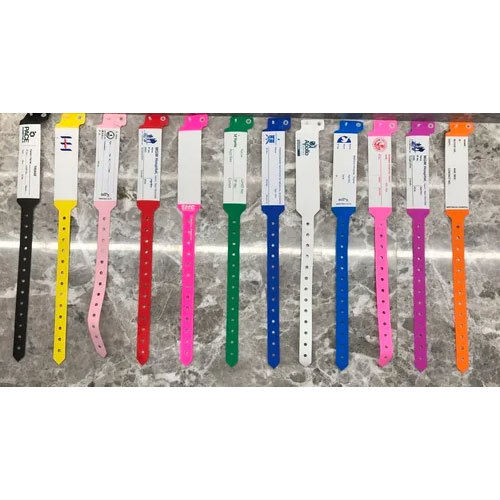The Significance of a Patient Identification Band in Improving Hospital Patient Tracking Systems
Exploring the Numerous Kinds Of Patient Identification Band Made Use Of in Medical Facilities
In the intricate globe of health care, the critical function of Patient Identification bands typically goes unnoticed. These bands, varying from easy paper wristbands to innovative RFID bands, develop the backbone of Patient safety and security procedures, ensuring accuracy in Patient Identification. Yet, the huge variety of these bands, each with its special benefits and limitations, is frequently overlooked. As we browse via this subject, one might acquire insight right into the refined complexities and crucial importance of such bands in clinical facilities.
Comprehending the Significance of Patient Identification Bands
While they might seem like mere accessories, Patient Identification bands play a crucial function in medical facilities. These bands offer as a critical device for validating Patient identity, stopping clinical mistakes connected to misidentification. Patient Identification bands also help in streamlining administrative tasks, ensuring exact record-keeping and invoicing.
Standard Paper Wristbands: Their Usage and Limitations
Traditional paper wristbands have actually been a staple in Patient Identification throughout various clinical facilities. While their use is prevalent, they nurture certain constraints that might impact their performance in Patient management. This section will concentrate on the scope of their application and the inherent disadvantages related to their usage.
Paper Wristbands: Usage Extent
In the world of Patient Identification, paper wristbands have long held a crucial duty. These bands are usually used in outpatient setups, where the Patient's remain is temporary. The wristbands have vital information such as the Patient's name, date of birth, and an one-of-a-kind Identification number. This simple, yet reliable system, enables medical specialists to rapidly and properly identify people, making certain the appropriate therapy is provided. Paper wristbands are also made use of in emergency situation scenarios, where fast Identification is critical. Their use reaches events like blood donation drives and mass inoculation programs, additionally emphasizing their versatility. Despite innovations in innovation, the humble paper wristband remains a cost-effective and reputable remedy for Patient Identification in different medical care circumstances.
Limitations of Paper Wristbands
Regardless of their widespread use, paper wristbands are not without their downsides. Their physical durability is one of the substantial restrictions. Exposure to water, sweat, or misuse can render them unreadable or even trigger them to degenerate. In addition, paper wristbands usually do not have the technological abilities of more modern alternatives, such as barcoding or RFID chips, restricting their capability to simply showing written details. The lack of ability to update or customize the data on the wristband is an additional drawback. Moreover, if the information is transcribed, clarity can be compromised, leading to possible misidentification. Ultimately, paper wristbands can cause pain or skin inflammation to some clients, specifically when used for extended durations.
Barcoded Wristbands: Developments in Patient Identification
While Patient Identification has long been an essential aspect of medical care, the advent of barcoded wristbands symbolizes a significant leap forward. These bands take advantage of the simplicity of barcoding innovation, permitting Patient information to be promptly scanned and accessed. They enhance the speed and precision of Patient Identification, lowering the risk of medical errors related to misidentification. Barcoded wristbands are economical, very easy to produce, and eliminate handwriting errors typical with hand-operated systems. Nonetheless, they are not without limitations. While they use renovations over traditional bands, the barcode can become smudged or worn, providing it unreadable. Despite this, barcoded wristbands stay an important device in modern-day healthcare settings, representing the junction of technology and Patient treatment.
Radio Regularity Identification (RFID) Bands: an Action In The Direction Of Futuristic Healthcare
The evolution of Patient Identification bands has actually produced the emergence of Superhigh frequency Identification (RFID) Bands (patient identification band). These innovative tools present key advantages for healthcare facilities, offering a more efficient and technologically advanced means of Patient Identification. The execution of RFID in medical care is a significant step towards a much more futuristic strategy to Patient administration and safety
Understanding RFID Bands

RFID Bands: Secret Advantages
Accepting a patient identification band future where innovation and healthcare combine, radio regularity Identification bands use numerous crucial advantages. Mainly, these bands improve Patient safety and security by giving precise, instant Identification, consequently minimizing medical mistakes. RFID bands can save a huge quantity of Patient information, consisting of clinical history and allergies, allowing personalized care. They likewise enhance administrative jobs, as the automated data access replaces manual procedures, improving performance and decreasing paperwork. RFID bands use real-time tracking of clients, crucial in risky environments such as surgical treatment or intensive care. These bands are resistant and long lasting to ecological aspects, ensuring constant capability. In general, RFID bands stand for a substantial development in Patient Identification modern you can check here technology, benefiting both clients and doctor.
Executing RFID in Healthcare
These bands supply a seamless means to track and identify patients, guaranteeing their safety and boosting effectiveness in treatment procedures. RFID bands minimize medical mistakes by offering exact Patient Identification, which is essential in protecting against misdiagnosis or wrong medicine administration. Therefore, the implementation of RFID bands is a substantial step in the direction of boosting Patient security and healthcare shipment.

Color-Coded Wristbands: Assisting in Quick and Accurate Medical Diagnosis
In the dynamic atmosphere of a medical facility, color-coded wristbands have become crucial tools for swift and accurate Identification of a person's clinical condition. These wristbands, worn by people, lug particular colors that represent different medical conditions or standings. For example, red might indicate allergy threats, while yellow may represent a fall threat. This system is created to offer immediate aesthetic hints to health care service providers, boosting Patient safety and security and care quality. In emergency scenarios, making use of these wristbands permits quick decision-making. Nevertheless, the effectiveness of color-coded wristbands depends upon the uniformity of shade interpretation across healthcare establishments, calling for typical criteria for constant application.
Approaches for Efficient Implementation and Monitoring of Patient ID Bands
Achieving optimal use of Patient Identification bands demands a well-structured strategy for their implementation and monitoring. The initial action entails training all health employees on the value of correctly applying and reading these bands. Secondly, health centers must standardize making use of ID bands throughout all divisions, ensuring uniformity and reducing discrepancies. Routine audits ought to be conducted to confirm adherence to plans and to remedy any type of disparities. Patient education and learning is likewise important; clients must recognize the objective of the bands and the requirement for their constant wear. patient identification band. Last but not least, it's vital to have a backup plan in area, such as barcode scanning or biometrics, to make sure that Patient Identification is never compromised.
Verdict
Patient Identification bands are important in clinical facilities to guarantee security and precision. Reliable execution and management of these bands can considerably minimize clinical mistakes, improve performance, and boost total Patient treatment.
These bands, varying from simple this article paper wristbands to advanced RFID bands, form the backbone of Patient safety procedures, making sure accuracy in Patient Identification.The development of Patient Identification bands has brought regarding the introduction of Radio Regularity Identification (RFID) Bands. Generally, RFID bands stand for a considerable improvement in Patient Identification technology, benefiting both patients and healthcare service providers.
RFID bands decrease medical mistakes by giving exact Patient Identification, which is important in stopping misdiagnosis or wrong medication administration. Patient education and learning is likewise important; clients must understand the objective of the bands and the demand for their continuous wear.